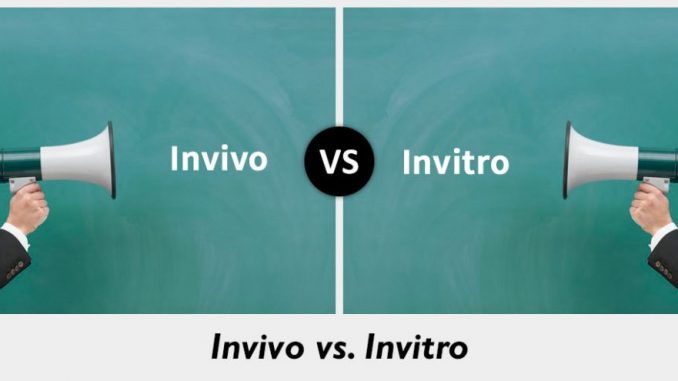
In-vivo and in-vitro fertilization two different methods of fertilization that occurs between the female egg and male sperm in different setting. Simply understanding, in-vitro fertilization refers to the fertilization of egg and sperm within the human body (female) while in-vitro fertilization refers to the fertilization outside the human body i.e. in laboratory. Some other difference between in-vivo and in-vitro fertilization are:
| In-vivo fertilization | In-vitro fertilization |
| In-vivo fertilization refers to the normal method of fertilization between female egg and male sperm within a human body. | In-vitro fertilization refers to the artificial method of fertilization between female egg and male sperm outside a human body |
| The term in-vivo came from the Latin word “within the living” | The term in-vitro came from the Latin word “within the glass” |
| It is a natural/normal method of reproduction that occurs in uterus/womb of female body | It is an artificial method of reproduction done in laboratory using different humanized techniques |
| This method of fertilization is normal and natural among couples | This method of fertilization is chosen to cure infertility in human, either male or female |
| It is a non-surgical method of fertilization | It is a surgical method of fertilization |
| Babies born through this method are considered as normal babies | Babies born through this method are called ‘test-tube-baby’ |
| From chemical perspective, during in-vivo fertilization all chemical reactions between the egg and sperm occur within the human body | From chemical perspective, during in-vitro fertilization all chemical reactions between egg and sperm is conducted in laboratory |
| None of the chemical changes and reactions are in human control as everything occurs within human body | All the chemical changes and reactions are in human control/in a controlled environment as this fertilization is conducted outside human body |
| It is a simpler technique of fertilization | It is relatively a more complex technique as it involves surgical procedure to retrieve the eggs |
| The cost per treatment is lower | Cost per treatment is higher and causes higher financial burden |
| This method provides limited information during check up and treatment | This method provides valuable information during treatment as the reactions between egg and sperms are evaluated initially in the lab setting |
| It can be also considered as an experiment done using a whole living organism | It can be also considered as an experiment done outside while living organism |
| This method of fertilization is suitable for fertile couple who don’t have any reproductive health complications | This method of fertilization is suitable for infertile couple/s that has some complication related to reproductive organs. |
| It is a not an assisted method of fertilization | It is a physician assisted method of fertilization |
| This method does not have risk of multiple pregnancy | The risk associated with this method is the possibility of multiple pregnancy |
References
http://www.technodoze.com/biology/in-vivo-and-in-vitro-fertilization.html
https://www.ncbi.nlm.nih.gov/pubmed/15196719
http://www.ejog.org/article/S0301-2115(04)00021-1/fulltext
https://www.quora.com/What-are-the-differences-between-in-vitro-and-in-vivo
http://medical-dictionary.thefreedictionary.com/in+vivo+fertilization
https://answers.yahoo.com/question/index?qid=20070325154234AAd2sbb
http://www.givf.com/fertility/ivf.shtml
http://www.advancedfertility.com/ivfchanges.htm
https://link.springer.com/article/10.1007/BF00319585
http://onlinelibrary.wiley.com/doi/10.1002/jez.1401950307/abstract
http://science.jrank.org/pages/3541/In-Vitro-in-Vivo.html
http://www.reproduction-online.org/content/134/1/63.full
https://www.quora.com/What-is-the-difference-between-in-vivo-and-in-vitro
http://www.majordifferences.com/2013/02/difference-between-invivo-and-invitro.html#.WR7ABJKGPIU
https://www.ncbi.nlm.nih.gov/pubmed/9261882
https://mpkb.org/home/patients/assessing_literature/in_vitro_studies
https://www.researchgate.net/post/What_is_the_difference_between_Ex_vivo_and_In_vitro